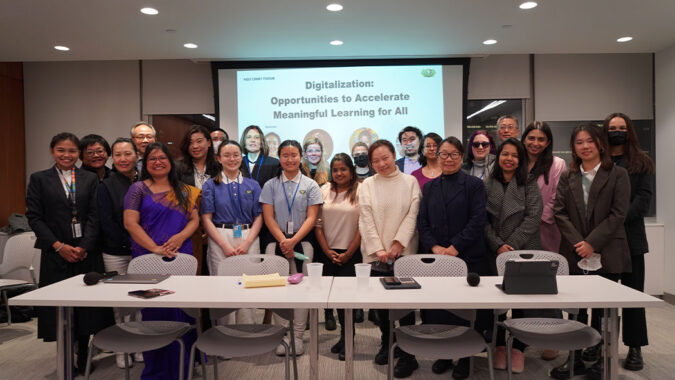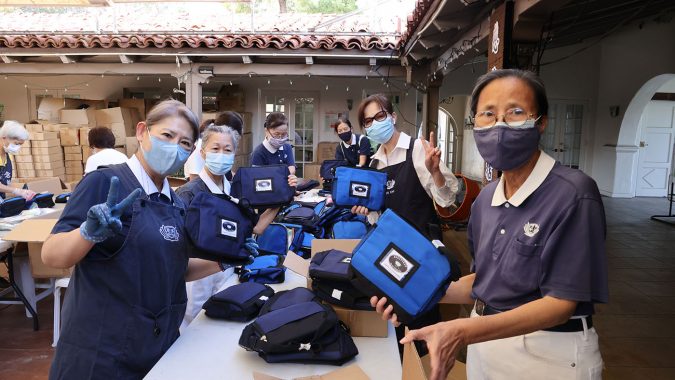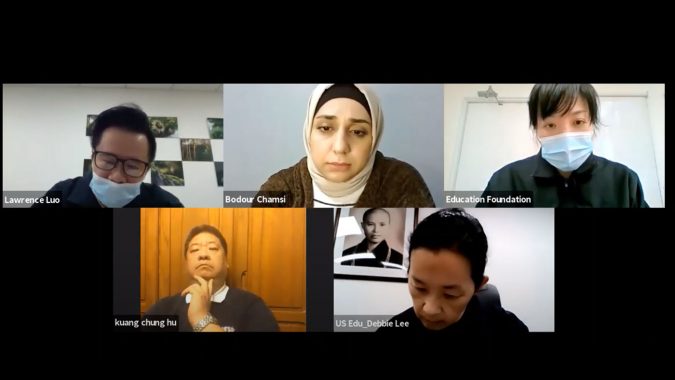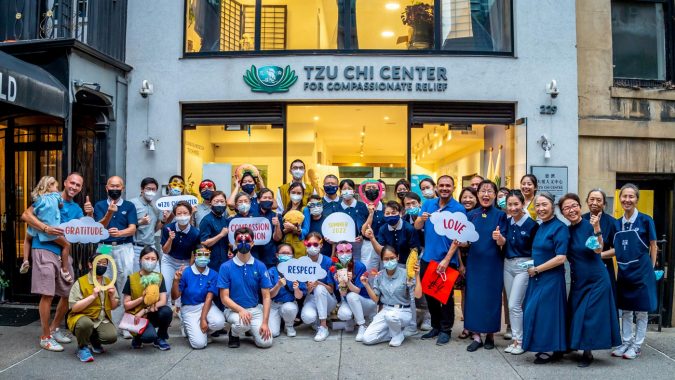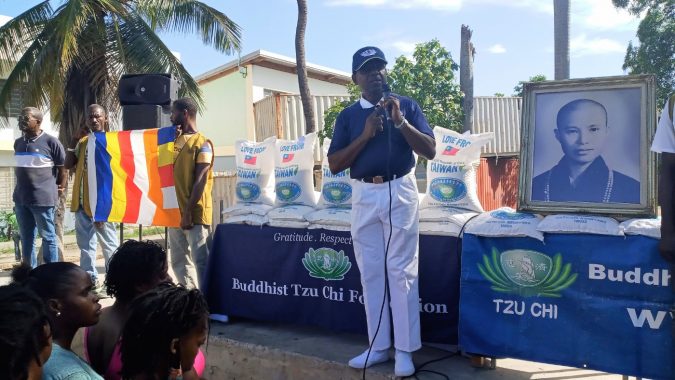
Written by Lineth Brondial and Huan Xun Chan
Edited by Adriana DiBenedetto
Lineth Brondial, from the Philippines, and Huan Xun Chan, from Malaysia, were part of an official Buddhist Tzu Chi Foundation delegation during the first week of COP27, November 6–13, 2022. They were selected via a pool of participants from the International Youth Leadership Program, a global young leaders’ training program of Tzu Chi and Tzu Chi International Youth Association that empowers youths while tackling Sustainable Development Goals.
Rising from the land of one of the oldest civilizations in history, the United Nations Conference of Parties on Climate Change (COP27) in Sharm el-Sheikh, Egypt, was a profoundly symbolic event that reflected upon the footprints of past conferences. We approached the venue while looking through the glass window of an electric bus, at the view of the mountains of the Sinai Peninsula before us. This part of Egypt sits on the coastal strip of the Red Sea, with the sun blazing profusely – hours apart from our original time zones.
This marks the fifth time that COP has been held in Africa on record, a continent listed among the most vulnerable to the wide-ranging effects of the global climate crisis. It sends a strong message to hold the biggest climate conference where the impacts of climate emergencies are deeply felt. Food insecurity, poverty, and more have long been faced by low-income countries around the world. In the Global Report on Food Crises 2022 Mid-Year Update by the World Bank, “At least one in five Africans goes to bed hungry and an estimated 140 million people in Africa face acute food insecurity.” This is a glaring statistic that no amount of well-prepared speeches, pledges, and big events can put out of sight.
The logo for the 27th session of the United Nations Conference of Parties incorporates African and Egyptian cultural identities – essentially, the African sun meeting Egypt’s sun God Aten, worshiped in the era of Pharaonic King Akhenaten, with their rays extending across the horizon. In general, the sun is an active representation of life, sustenance, and a sign of hope. With the effects of global warming upon us and the approaching term-end for the ideal 1.5ºC limit set by the Paris Agreement in 2015, it was promising to see the sun in this year’s logo.

The venue was divided into two zones: the Blue Zone, where key negotiations, high-level meetings, side events, and pavilions were held; and the Green Zone served as the main platform for the business community, civil and indigenous societies, academia, and the government of Egypt to introduce their programs regarding climate solutions. The Pavilions at the Blue Zone were a much busier maze, with multiple side events happening simultaneously and too many focus areas to take in at once. Everyone sought for their voice to be heard.
Daily, thematic topics were assigned to enable broad interactions with various stakeholders. These included biodiversity loss, energy transition, decarbonization, adaptation, solidarity, water, agriculture, finance, gender, and loss and damage, to name a few.
COP has had a long history of meetings since 1995 as the official platform of the United Nations Framework Convention on Climate Change (UNFCCC). From 154 countries that signed up for a treaty on international cooperation for climate matters, the delegation grew to encompass 197 parties and observer organizations, including the Buddhist Tzu Chi Foundation, to meet yearly to tackle global solutions and funding mechanisms to mitigate greenhouse gas (GHG) emissions. Over time, COP has leaned toward assisting developing and vulnerable countries to manage the impacts of global warming and hold developed nations accountable for climate impacts. Africa, for example, only records 3% of global CO2 emissions, but it carries on its shoulders the pains of climate change outcomes together with other marginalized regions.
The Climate Clock
Greenhouse gas emissions keep growing. Global temperatures keep rising. And our planet is fast approaching tipping points that will make climate chaos irreversible. We are on a highway to climate hell with our foot still on the accelerator.
António Guterres
Secretary-General of the United Nations
In the opening ceremony of COP27 on November 6, António Guterres, Secretary-General of the United Nations, expressed how the UN Climate Conference reminds humans that we have the answer in our hands. The Conference of Parties is an instrument that can help form the most significant coalition for the climate.
But above all, a critical benchmark is moving – time. In about six years and 220+ days remaining, the carbon budget will be depleted, as reflected on the Climate Clock, which records the timeline between 2020 and 2030. By then, it will be too late to reach global sustainability targets. The blinking LED clock was hanging strategically at the Children and Youth Pavilion, the Innovation Hub, and other key zones serving as a reminder to the thousands of people at COP: the time to act is now.

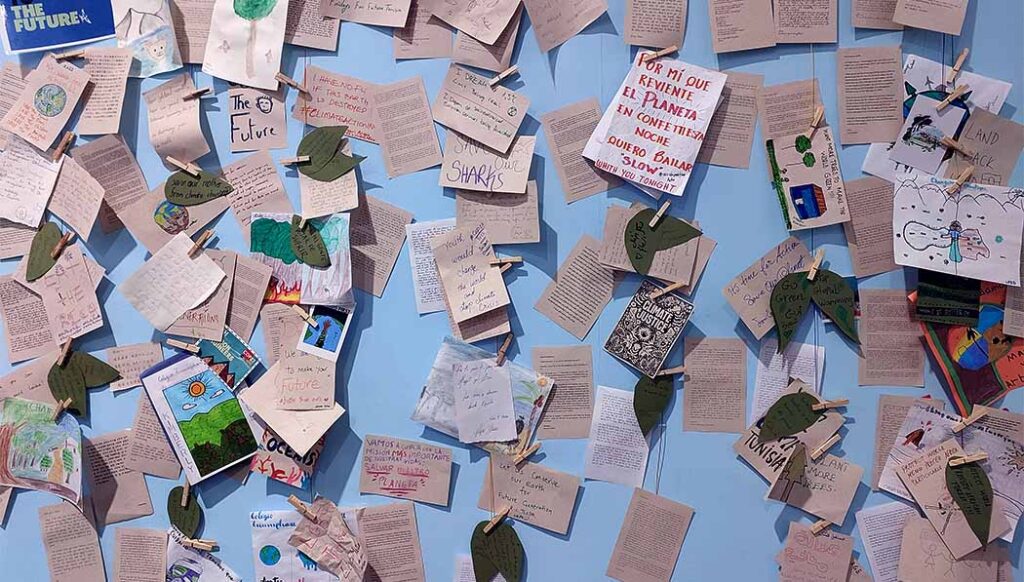
At present, the Earth is already 1.1ºC warmer than it was in the late 1800s. The highest levels of average annual global greenhouse gas emissions in human history were recorded between 2010 to 2019. This was during the same period when COP produced documents, treaties, and mechanisms such as the Green Climate Fund, the Durban Platform for Enhanced Action, the Doha Climate Gateway, the Warsaw Mechanism, the Lima Ministerial Declaration on Education and Awareness, the Paris Agreement, discussions on the Adaptation Fund, the Powering Past Coal Alliance, and the finalization of Paris Agreement’s rulebook – all to reduce and manage the destructive human activities that unbalance our ecosystem.
By 2020, all climate ambitions were impeded and the world faced the biggest challenge yet: A coronavirus pandemic in contemporary times, with all countries grappling against one life-altering crisis after another.
Together for Implementation
Our COP process is unique. We must create a safe political space, shielded from whatever else is going on ‘out there,’ to do our jobs and deliver world change.
Simon Emmanuel Kervin Stiell
Executive Secretary
United Nations Framework Convention on Climate Change
Briefly, Goal 17 of the Sustainable Development Goals (SDGs), as outlined by the United Nations, talks about partnership – to “enable a sustainable future through the joint action of countries and communities.” It talks about a strong commitment to providing the technological and financial means to make the vision of sustainable development a reality.
Perhaps one of the most transformative and ambitious partnerships happened seven years ago when 194 countries signed up for the Paris Agreement. With this, signatories committed to setting out national agendas for reducing carbon emissions, known as Nationally Determined Contributions (NDCs). This agreement has become a reference for most, if not all, climate proposals going forward. Global warming was acknowledged as a destructive phenomenon damaging and destroying the sustainability of lives, livelihoods, and ecosystems. To achieve the ultimate goal, mid- to long-term goals were identified: First, to reduce carbon emissions by 45% compared to 2010 levels by 2030, and second, to reach net zero carbon emissions by 2050.

The Paris Agreement highlights the importance of net zero because it is nearly impossible for the world to stop all activities that emit greenhouse gases, especially on the timescale of climate emergency. Achieving the net zero balance between anthropogenic greenhouse gas (GHG) emissions by sources and removals by sinks of greenhouse gases, such as by sustainably increasing afforestation, is therefore ideal.
Paris gave us the agreement. Katowice and Glasgow gave us the plan. Sharm El-Sheikh shifts us to implementation.
Simon Emmanuel Kervin Stiell
Executive Secretary
United Nations Framework Convention on Climate Change
In his remarks, UNFCCC Executive Secretary Stiell laid out three critical lines of action for COP27:
- Deliver the transformational shift to implementation and put negotiations into action.
- Cement progress in mitigation, adaptation, finance, and loss and damage.
- Enhance the delivery of principles of transparency and accountability throughout the process.
COP27’s theme, “Together for Implementation,” acknowledges the urgency of working out plans through synergism, the combined action of all stakeholders. While the hope for COP had been to see progress on the transition to net zero, the real translation from agreements and pledges to projects and programs is particularly challenging, especially amidst geopolitical tensions, the pandemic, and food and energy crises. The Welcome Message from President Abdel Fattah El-Sisi, President of the Arab Republic of Egypt, underlines the aspiration to move forward from negotiations and plan for implementation based on all the promises and pledges made in previous annual conferences.
I deeply believe that COP27 is an opportunity to showcase unity against an existential threat that we can only overcome through concerted action and effective implementation.
Abdel Fattah El-Sisi
President of the Arab Republic of Egypt
Grassroots Voices
COP negotiations and outcomes are party-driven, but it also gathers non-party stakeholders composed of members of civil and indigenous societies and includes farmers, researchers, businesses, and youths, who relentlessly strive to boost grassroots voices.
Among the sea of people, it was not hard to recognize Indigenous Peoples’ culturally distinct clothing at the event. The Indigenous Pavilion holds a critical space for Indigenous voices to share knowledge, experiences, and solutions for addressing our changing climate. One person alone does not hold the key to solving a global catastrophe. The key lies in recognizing every community’s essential role and upholding the rights of all.
Through the years, members of the Winnemem Wintu tribe have coexisted with the mountains and rivers at the foot of Mount Shasta in Northern California. They have an Annual Salmon Run to celebrate the gifts of the ocean, the land, and the volcano. But the dams that were built, and more developments after, are endangering the life of the salmon that help balance the ecosystem. This also imperils their community life as a result.
“In a lot of areas, Indigenous Peoples are going to be the first ones to be flooded out. They are going to be without water first. They are going to be in contaminated areas; it’s that way already. The first people to feel it are already feeling it,” shared Caleen Sisk, Chief and spiritual leader of the Winnemem Wintu tribe, a salmon-shaped pendant adorning her neck.
Marciely Ayap Tupari, Communicator of the Coordination of the Indigenous Organizations of the Brazilian Amazon (COIAB), donned blue-and-white feathers as she spoke with those in attendance. The Amazon rainforest is considered to be the most important ecosystem – the lungs of the world – home to more species of plants and animals than any other ecosystem on the planet. But the Amazon has been struggling under the massive threats of rampant deforestation, oil and gas extraction, fires and drought, and current trends in livestock and agriculture.


Marciely shared that she is not only representing the Tupari people, but the entire Amazon rainforest community; she wants to let the world know about the real climate situation in the Amazon as impacted by Brazilian politics, and the challenging politics of climate change as a whole.
During key conference talks, Indigenous Peoples and Pacific Island nations have come forward to seek climate justice to hold major global carbon emitters accountable for rising sea levels, prolonged heat waves, and other extreme weather events. In the UN climate talks, this is categorized under Loss and Damage, which refers to the severe climate impacts in vulnerable countries.
By the end of negotiations on November 20, the parties were able to establish an agreement for Loss and Damage funding, which aims to catalyze assistance for developing countries that are hit hard by disasters.
Time for the Ocean
If there is any representative topic to best describe life’s interconnectivity, it is the ocean. All of the world’s bodies of water connect; all streams and rivers end in the ocean. We are sandwiched between the same boundless sky and bodies of water, and so what happens to one happens to all, albeit at different places and times. And, water sustains us all.
The ocean is the cornerstone of Earth’s life support system… In short: No blue, no green. No ocean, no life.
Dr. Sylvia Earle
Marine Biologist & Oceanographer
The ocean covers 70% of the planet, absorbing over 30% of global carbon emissions and 90% of the warming that has occurred in recent decades due to increasing greenhouse gases. What’s more, roughly half of the oxygen production on Earth comes from the ocean. Ironically, in the 27-year history of COPs, the ocean has never been a core focus at the global climate summit. Last year, in Glasgow, was the first time the ocean was integrated across all areas of work under the UNFCCC. As of June 2021, only 22 out of 194 signatory countries of the Paris Agreement had put coastal and marine nature-based solutions in their national climate agendas.
Oceanic Global, an international non-profit organization pushing for the protection of the ocean by shedding light on humanity’s essential relationship to it, launched The Ocean X Climate Summit at COP27, drawing the attention of cross-sector leaders.
On the homepage of Oceanic Global, it writes, “The ocean is our biggest ally in mitigating climate change, but it’s also bearing the brunt of the climate crisis. It’s time the ocean takes center stage in the global agenda to protect our blue planet.”
Egypt is no stranger to this ocean-humanity relationship. COP27 took place in a Red Sea resort in Sharm el-Sheikh, one of the coral reefs fringe coastal towns that include Hurghada and Marsa Alam. At least 5% of the global reef cover is found in these Red Sea reefs, which also contain some of the most diverse reef species outside Southeast Asia.
As climate change continues to warm the ocean, the reefs are at risk of acidification as coastal construction, overfishing, and tourism affect their habitat at the same time. According to the Global Coral Reef Monitoring Network, 14% of the world’s reefs were already lost between 2009 and 2018 as a result.
Inspiration to Take Local Actions
Two weeks is short to take everything in from a conference as large as COP27. It takes a particular energy to be fully present in all the opportunities where knowledge, experiences, and solutions are shared. On the other hand, it is enough time to get a gist of what is going on, where we’re at, and how we can best move forward. Essentially, in this existential battle with our changing climate, there are no small or big actions because the Earth is counting on all kinds of solutions.
For the first time, youths were given a platform at COP. Right at the entrance within the Blue Zone, a decorated pavilion held a space for young people to collaborate, discuss, interact, do consultations, paint, or write letters to the future. It was an energetic atmosphere from a delegation who, despite coming from many different groups, altogether share a common generational identity.

For COP28, slated to be held in Dubai in November 2023, Al Mazrui says they will make it more inclusive of youth participation and that she looks forward to a COP that promotes tolerance, peaceful coexistence, and love at its core in the climate global agenda. Photo/Lineth Brondial
Nisreen Elsaim, Chairperson of the Sudan Youth Organization for Climate Change (SYOCC), talked about the two important steps that can strengthen the influence of youth: Getting together and being present. These are in themselves a message to adults at the table, she said, that the young generation is here, watching what they’re doing. And, they can flip the script at any moment because the voices of our youth are the voices of our future. Nisreen attended her eighth COP this year, and the message shared by her generation remains just as pertinent.
We have the same message: We’re running out of time; we need climate actions. We need climate finance. The messages are not happening. That’s why we’re still having COPs.
Nisreen Elsaim
Chairperson
Sudan Youth Organization for Climate Change
The year that we will no longer need COP must be a time somewhere in the not-too-distant future, wherein you and I can live if we’re fortunate enough: The trees must be greener; summer temperatures must occur during the appropriate season; fish mustn’t choke on human-made ocean pollutants; skin color should not restrict opportunity; developing countries can be disaster-resilient; the Amazon must still breathe life for all that depend on it. The Earth must be at less than 1.5°C.
Very recently, the global population has reached eight billion, and along with each headcount is a carbon footprint – the human impact that contributes to the already record-breaking environmental threats for future generations. Even if we combined all the COP delegations for the past 27 years, it would still run short of the global headcount.
The challenge will not be easy, but it is necessary to bring these discussions to communities and people outside of COP attendance. Going to COP has taught us that transformations across systems must occur, and it includes our behavior in coexisting sustainably with the environment. In reality, if we want more awareness, our main platforms are not the negotiation tables or the conference halls; they are the dinner tables we share with our families, our small circle of friends, and the streets in our communities.
Coming all together, we shall take it from here.
Climate justice must end in our generation; young people have the energy and sensitivity to tackle this. Youths may be naive and unrealistic but it is exactly what is required now. [We] need new energy. Think outside the box and work together to achieve these dreams.















